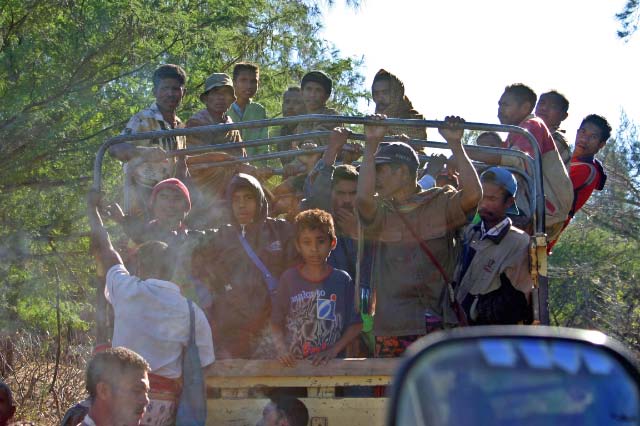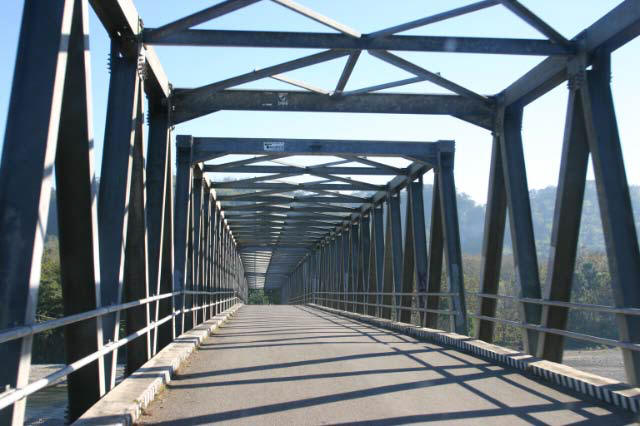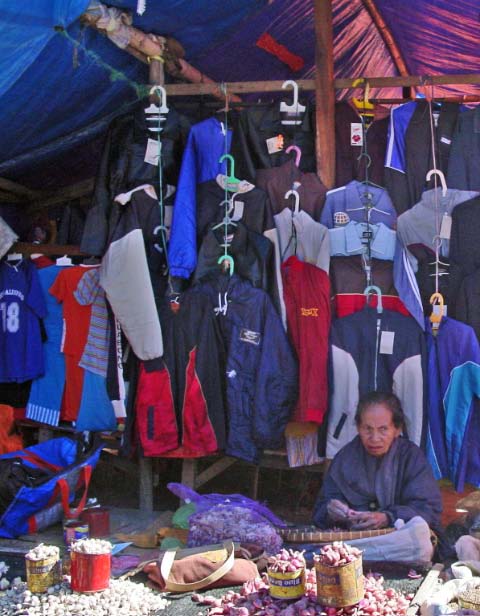|
| |
|
TOUR TO BOTI, TIMOR - INDONESIA
|
July 28
The rally had organized tour guides that were University students majoring in English. But we were not aware of this when we booked our tour with an official "looking" guide.
The rally had organized tour guides that were University students majoring in English. But we were not aware of this when we booked our tour with an official "looking" guide (he evidently found one of the Rally guide’s nametags) that fraudulently passed himself off as an official Kupang Rally guide. He promised to take us to about 6 different venues, including the remote village of Boti. As it turned out it took over 5 1/2 hours each direction just to get to Boti so there was no time for anything else. But because of the unknowing mistake, we were the only ones that got to see this remote village as the official guides knew better than to
attempt such a journey in one day!
Our group consisted of Gone with the Wind, Tactical Directions, Stardust and ourselves. After dragging Annie & Liam from a deep "morning after" sleep to shore at 5 am, we departed for a little town called Soe via the public transport bus. As with the Bemos, there were several "money collectors" hanging out the door. At that time of the morning it was really cold and we all sat shivering from the breeze of the open doorway. It was fun visiting with the locals as they boarded the bus with bags of rice, babies, and whatnot, during our 2 1/2 hour trip to Soe. |
 |
|
 |
|
 |
 |
 |

|
|
Long bamboo poles to support construction of new buildings
|
We stopped at a roadside foodcart that sold some kind of deep fried cake and we bought a bag to share around the bus |
Diesel (solar) is sold by the roadside in 1 litre bottles for about 5000 rp (50 cents) per litre |
|
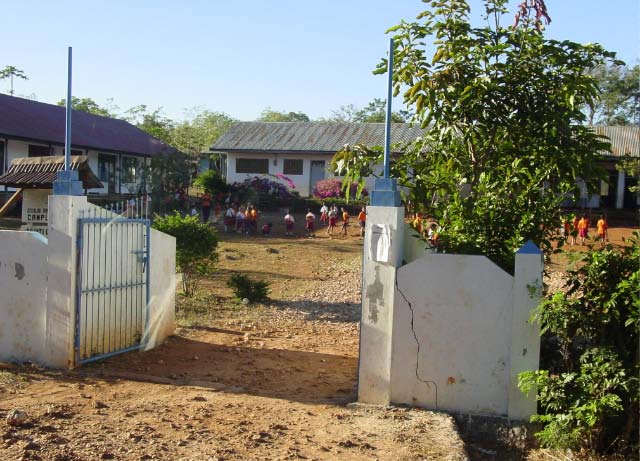
|

|
|

|

|
|
Our bus trip took us past some school yards full of the local children in their uniforms, always clean and starched looking.
|
We passed sell-everything storefronts and busy roadside
streets full of activity. |

|
 |
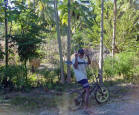 |
 |
|
The semi sealed narrow road cut through villages where people along the roadside would give us a friendly wave. |
|

Whole families seemed to just congregate along the roadside.
At one point, when the bus stopped briefly, a group of boys rushed out to sell us eggs (cooked), pastries and other goodies through the bus window. |
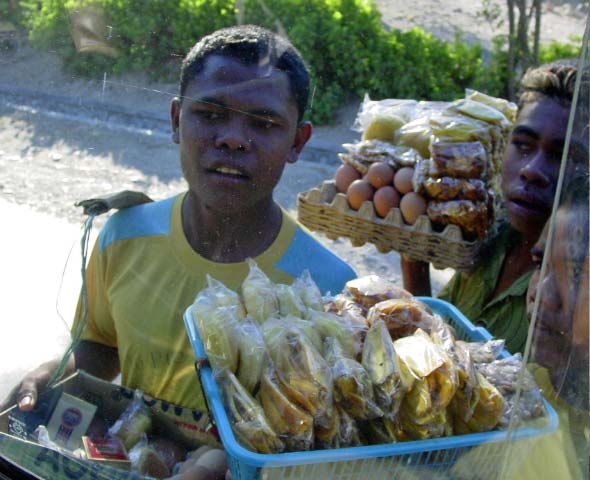 |
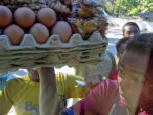 |
|
 |
 |
 |
 |
|
All sorts of bulk bins full of rice, pulses, grains and spices complete with weevils! |
No refrigeration...no problem. Chickens are sold FRESH. |
The fruit was a bargain |
|
An Incentive to Hold It
Before we continued on, the girls wanted to find a toilet (WC) but when we were directed to the public facility none of us wanted to use it. The bathroom was a dirty cement room with four cubicles, not all with doors. Inside there was a hole in the floor covered in excrement, with 2 soggy slimy wet footholds on either side. Beside was a cement reservoir of water with a filthy floating bucket that you use to scoop the water to clean your nether region while still squatting over the toilet, and then you use another scoop for flushing. The experience put me off completely and from now on I will "hold it" even if that means ALL DAY! |
 |
|
Boarding the Bemo
At Soe we boarded a Bemo, all jamming into the small van and squeezing ourselves along the narrow benches. The plan was to drive to Boti, the most traditional village in Timor that supposedly several hours away. Along with our group were the guide, driver and two boys who rode in the usual position, hanging out the door. |
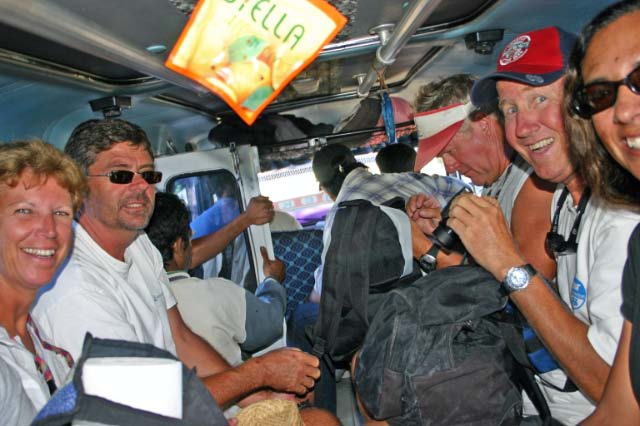 |
 |
|
At the time we didn't know that they would be a necessary accompaniment to throw boulders behind our wheels every time we spun out and stalled on all the steep inclines!We had no idea (nor did our "guide") of the trip that lay ahead. |
 |
The countryside along the way was rugged and tropical with sections of rice fields bordering the highway.
|
 |
|
As we headed into the mountains the road got progressively rougher and steeper. When we reached a remote town of Oinlasi, our bemo left the road and continued on down a trail that was more like a riverbed, with large rocks, ruts, washed out sections and steep narrow
areas.
|
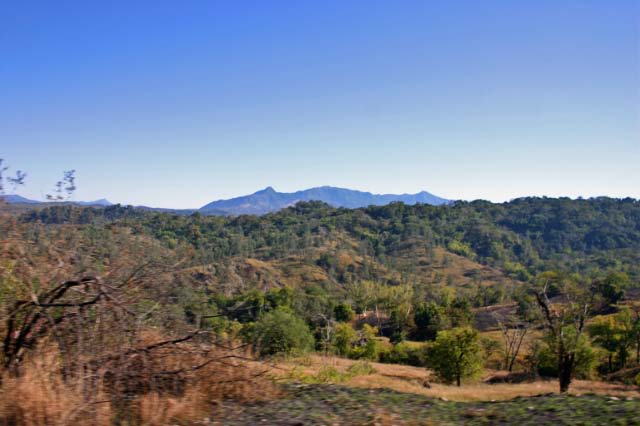 |
 |
|
Our tires
were inches away from the edge of precipices that dropped hundreds of meters. |
|
Get Out and Walk!
Many sections of the road were so vertical that the Bemo spun out and stalled, unable to reach the tops of the steep hills, so we all had to get out and walk. |
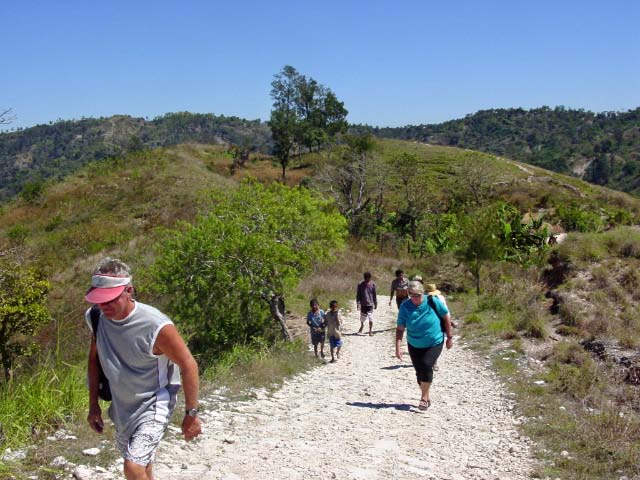 |

|
This happened many times so we got plenty of uphill exercise in the
smouldering heat of the day (none of us had water with us).
Sometimes locals would watch us walking, puzzled as to our situation. |
|
A variety
of Dwellings
The remote countryside was dotted with
various types of dwellings including
traditional thatched bee-hive shaped houses, houses erected of slim vertical bamboo poles and homes of cement. It seemed that almost every home had someone sweeping the dirt and everything was pretty neat.
|
 The Bemo Breakdown The Bemo Breakdown
After a couple of hours we were so far into the bush it was obvious this was not a road traveled by any type of vehicles. The van sputtered, coughed stalled, and would not start. So out we got again. The driver, along with the "doorway" boys, slithered under the van and removed the fuel filter. With a lit cigarette in his mouth the driver ran his finger along the edge of the filter to clean it out. We all quickly backed as far away from the bemo as possible.
Amazingly the bemo finally fired to life and away we went once again.
|
|
 |
BOTI VILLAGE
Finally we reached the tiny, isolated traditional village of Boti. Christianity never penetrated here and the presiding King (Raja) of Boti has maintained a strict adherence to tradition.
Indonesian education is shunned as is Christianity. These people lived in small huts built of wood and grass. Only clothes made from home spun cotton, grown in the village, can be worn. They dressed mostly in traditional Ikat sarongs and shawls. The men grow their hair long after they are married and wear it up in a knot on their heads. The women also wear their hair up on their head. The villagers do not speak Bahasa Indonesian so it is necessary to travel with a guide that converses in Boti, which we were sure that our guide did not. We were not informed that it is customary to present Betel Nut,
a mild narcotic, when arriving at the Raja's home. It was evident though that these people had an ample supply of Betel Nut, revealed
by their red teeth and bright red "lipstick" stains around their mouths, resembling the makeup of a circus clown! Both the men and women, young and very old, all had the proverbial red stained mouth. |
|
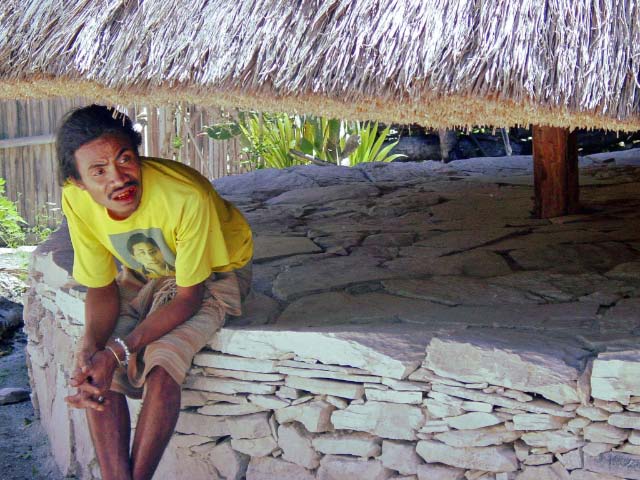 |
|
Meeting Royalty
At the house, we met the Queen, the King's son, the King's daughter and several other members of the “Royal family”. |
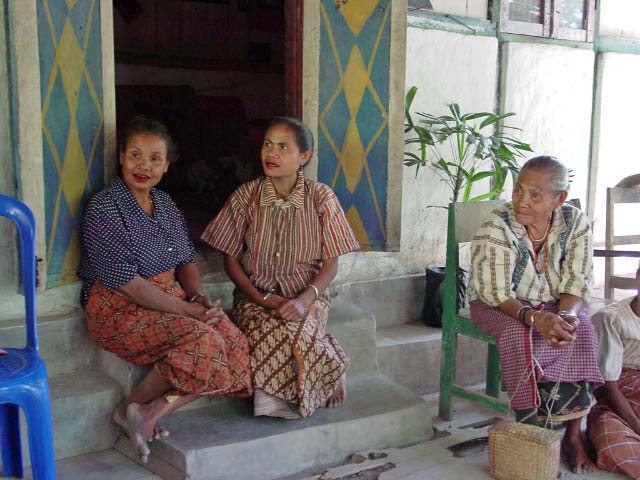 |
|
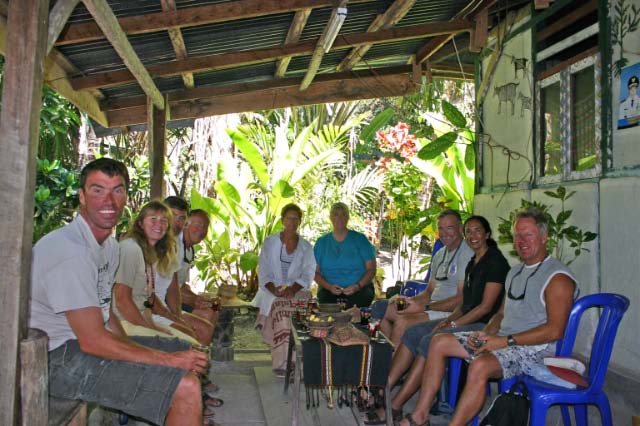 A framed photo of the King was put before us as we were informed that the King had recently died (a year ago) so in respect for him there could be no song or dance. After respectfully shaking hands with each individual we were asked to sit quietly as they presented their ceremony. A framed photo of the King was put before us as we were informed that the King had recently died (a year ago) so in respect for him there could be no song or dance. After respectfully shaking hands with each individual we were asked to sit quietly as they presented their ceremony. |
 |
Fresh hot battered deep fried bananas and boiled cassava were brought out to us, along with a delicious sweet tea. We ate but out of respect, our hosts did not eat but just watched us. We were all trying to remember our manners, no crossed legs, no pointing fingers, no left hands, no joking, but Liam was having a difficult time remembering his manners and it was hard not to laugh at all his fauz pas. |
 |
|
Then a bowl of Betel Nuts was brought to us, along with slender green lime leaves and a tube of white powder. |
|
Traditional Betel Nut Chewing
Liam volunteered to represent us all by chewing the Betel Nut. But this is a more complicated process that one would think. Firstly, you need to break into the hard shell of the nut, place it into your mouth along with the leaves of the lime tree, then you need to suck in some white chalk powder to cut the taste. This all turns into a nasty red paste that you spit out into a designated betel juice container. It was hard to keep a straight face but that is disrespectful and our Boti hosts do not smile let alone laugh!
Around the Village
Afterward we were shown around the village consisting of the sleeping houses, meeting house, outdoor kitchen and praying house, all traditional thatched buildings.
We saw the women weaving the traditional Ikat, cloth in which the pattern is produced by dying the individual threads before weaving.
|
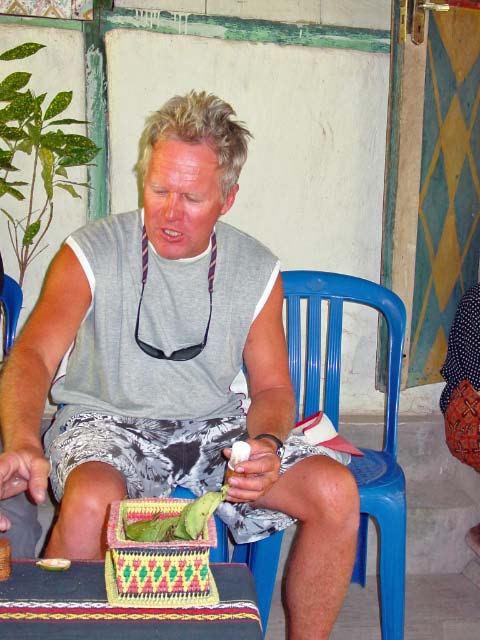 |
 |
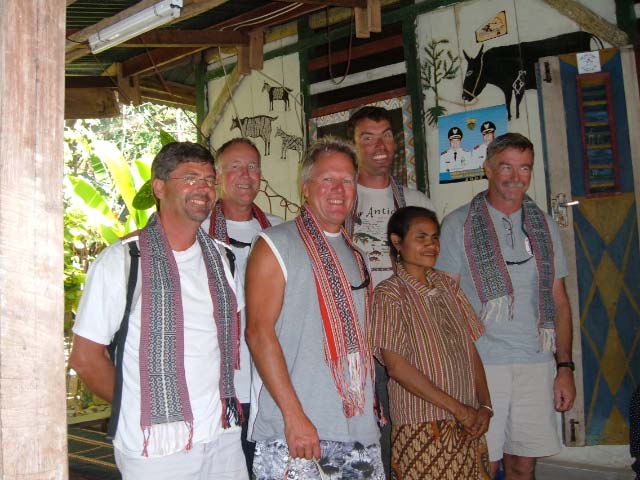 |
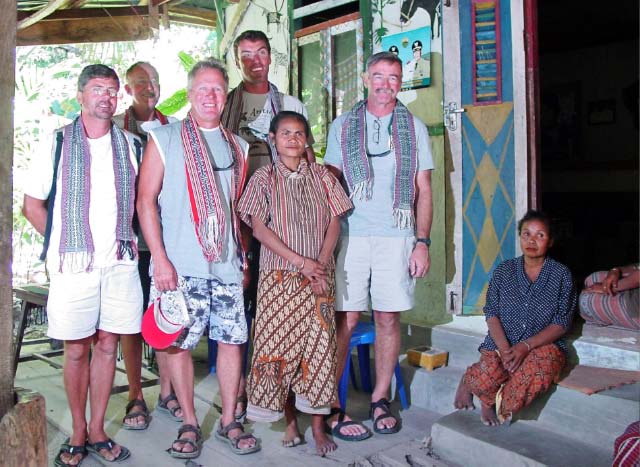 |
|
A gift to Remember...
Before we departed, the men were presented with gifts of beautiful Ikat
soti, a wide woven scarf placed around their necks. These weavings were truly a work of art, each uniquely patterned ikat hand woven and taking over a month to make! We were really overwhelmed by the generosity.
|
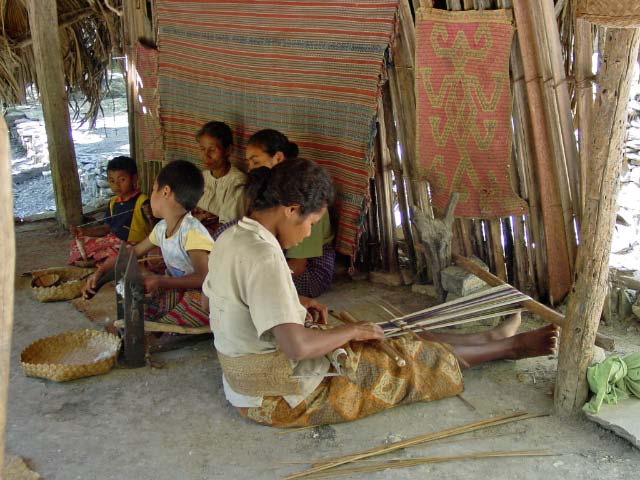 |
 |
We reluctantly climbed back into the bemo trying to get syked for the long bumpy ride back. Our back window carried a motif of Jesus with stained Betel Nut mouth!
We eventually arrived back in Soe, where we stopped for supper at an Indonesian restaurant. Numerous dishes of food were brought to our table, the idea that we would only be charged for what we ate. The over-fried chicken and rice were okay, but we passed on the tripe, heart and several other dishes of unknown origin. |
|
By now it was getting dark so it was evident that we would forego visits to the waterfall, monkey caves, and dance demonstrations so we asked to be taken back to Kupang.
|
|


